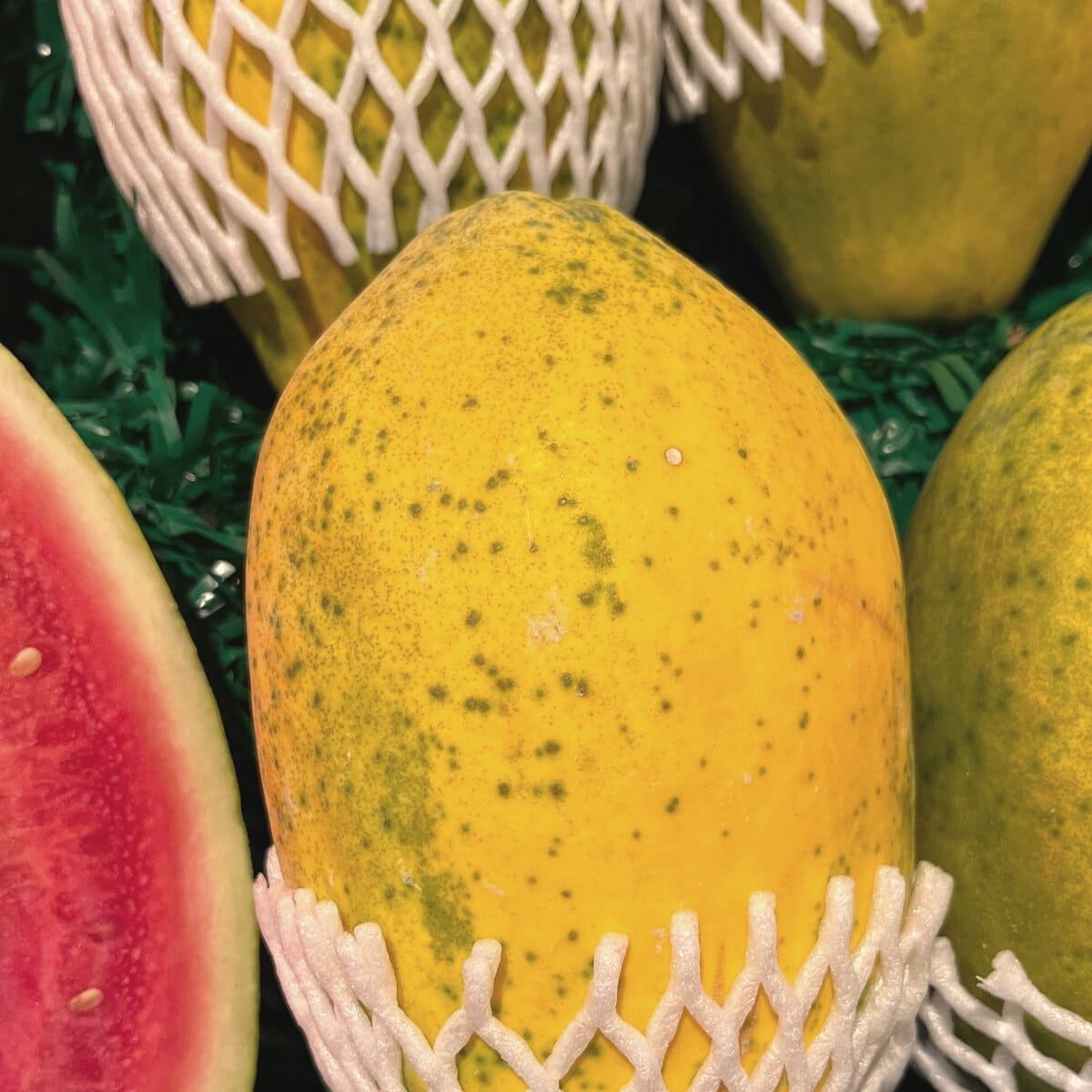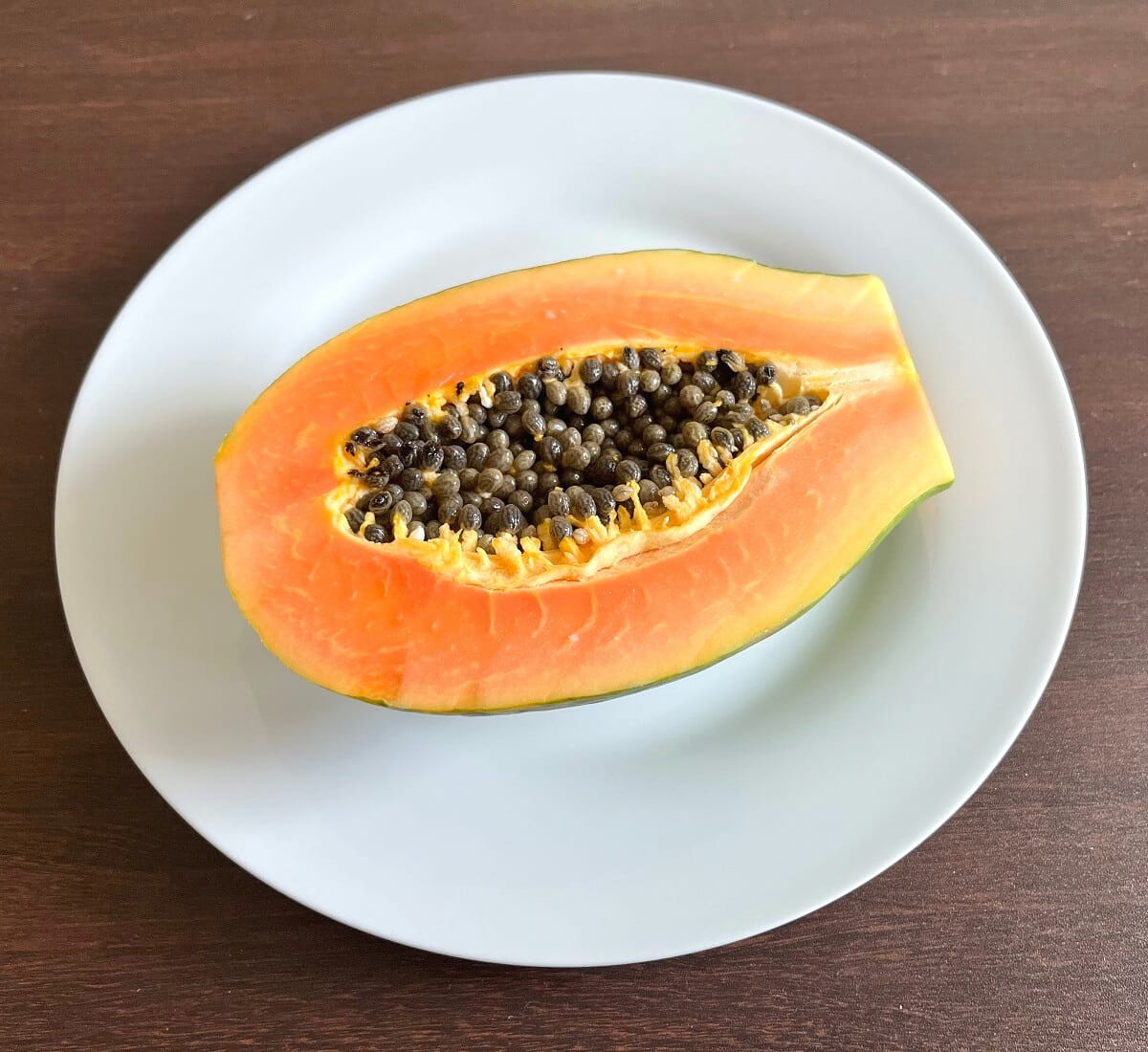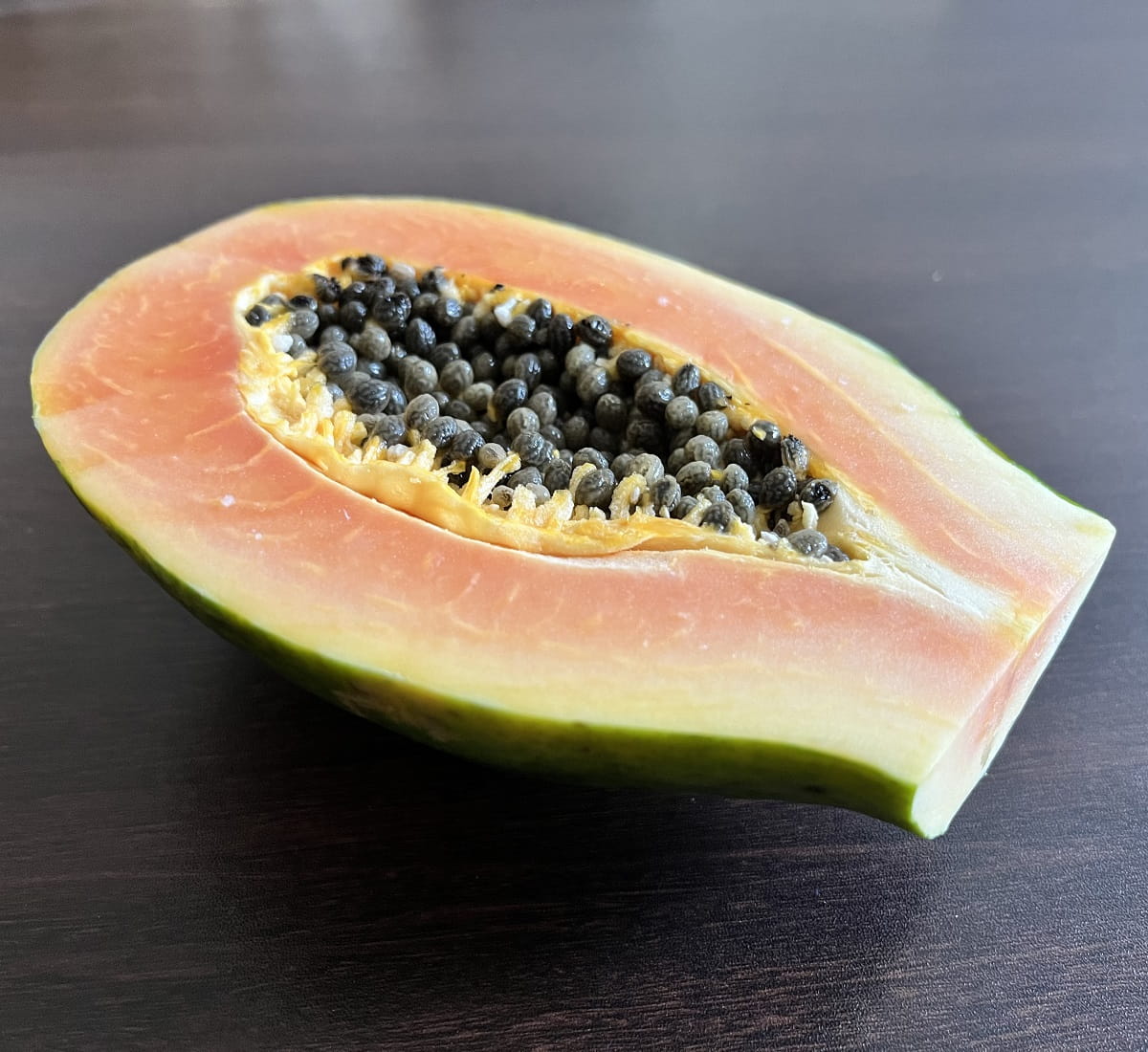Last updated: April 12, 2024
What is a papaya fruit, and how should we cut and eat it? This guide explains everything you need to know about eating the delicious papaya.
Papayas are versatile fruits that can be used in their unripe and ripe forms. But before you can dig into this savory or sweet tropical treat, you need to know how to cut it up.
In this article, I will show you how to cut and eat a papaya, and I will also give you some of my favorite tips for selecting, storing, and using this tasty fruit.
How to Eat a Papaya?
Before you can enjoy fresh or green papaya, you need to know how to cut this fruit open and prepare it. Luckily, this is a fairly straightforward process.
Steps to cut and eat papaya:
- Rinse the papaya under cold water to remove any dirt or other residue on its skin.
- Using a sharp knife, slice off both ends of the papaya.
- Cut the fruit in half lengthwise.
- Using a large spoon, scoop the seeds out of the middle of each half and discard or save for roasting.
- Place one clean half cut-side on the cutting board and slice lengthwise into thick strips. Repeat with the second half.
- Use a paring knife to remove the skin from each slice. This will be very easy with ripe papaya but requires more work when cutting into the dense flesh of green papaya.
- Cut the skinned slices into your desired shape and size.

You can enjoy ripe papaya in strips or cut those strips into cubes before eating.
Green papaya is typically sliced or diced for recipes. Reference the instructions for your recipe and cut the strips accordingly.
What Is Papaya?
Now that you know how to cut and eat papaya, let’s get to know this fruit a little better.
Origins
The papaya fruit is produced by the Carica papaya tree. This peculiar tree, which is actually a large herb, generally has a single long trunk, no branches, and a ring of leaves on the top. They look somewhat like a funny palm tree.
The large, oblong fruits grow directly from the trunk under the ring of leaves. These leaves fall off as the tree grows higher, making room for more fruits. A single papaya tree can have dozens of fruits growing off the trunk at one time.

These fruits are produced all year long in tropical regions. The tree is native to Mexico and Central America but is now widely grown around the world, including in India, Nigeria, and Brazil.
As long as they are protected from frost, Papaya can also grow in Southern California and Florida, and they thrive as a popular Hawaiian fruit.
Appearance
Papaya fruits start off deep green and turn yellow-orange as they ripen. Depending on the variety, they can be oval or oblong with an elongated neck.

Some large varieties can get as big as spaghetti squash, but most are about the size of a large mango.
Skin and Flesh
Inside the thick skin of the papaya is white flesh that ripens to orangish-pink or yellow, depending on the type. At the center are hundreds of round brownish-black seeds about the size of a peppercorn.
The skin of the papaya is not edible, but the flesh, whether ripe or not, is.

Unripe papaya (known as green papaya) has a smooth, dense texture, somewhat like a firm zucchini. The flavor is neutral to slightly sour with hints of the perfume taste of a ripe papaya but without the sweetness.
Ripe papaya flesh is slippery like a mango. It’s buttery and smooth with a flavor somewhere between cantaloupe and mango with fragrant undertones.
Seeds
The seeds of the papaya are edible, but they have a somewhat strong, peppery flavor that can be a bit too intense for some people’s tastes.

Most people scoop out the seeds and discard them, but you can certainly eat them if you wish.
They are often roasted to remove some of the bitterness, then crushed and used to season green papaya dishes.
Nutrition
The bright orange-pink flesh of papaya is rich in vitamins and minerals.
It has more than your daily recommended value of vitamin C, and lots of vitamin A, folate, and magnesium. It also has trace amounts of B vitamins, vitamin E, calcium, and potassium (source).
Papaya also contains plenty of fiber and a unique enzyme called papain. This enzyme helps break down proteins into usable parts that your body can easily absorb.
Tips and Recipe Ideas
Now that you know how to cut green and ripe papaya, here are a few more tips for working with and using this tropical fruit.
When is Papaya Ripe
A ripe papaya will be uniformly yellow without spots of green. When you give it a gentle squeeze, the flesh should give some. Perfectly ripe fruits will be just a touch softer than a ripe avocado.
If you live in a tropical or subtropical location, you’ll likely find only whole green papaya for sale at the store. To get the sweet flavor sensation of ripe papaya, you’ll have to bring the fruit home to let it ripen. Or, you can use it as a vegetable in its green form.

To select a quality green papaya, look for one that doesn’t have any brown spots or damage to its skin. If you want a green papaya, select one that is dark green in color, with no hint of yellow or orange. These fruits ripen fast once they start to turn colors.
If you plan to eat your papaya ripe, look for unblemished fruits that are already showing some yellow coloring at the base. These will be ready to eat sooner.
How to Store Papaya
Like other tropical fruits, papaya retains the best flavor when stored at room temperature. Place ripening papaya on the counter, where it will turn yellow and soften up over the course of days to about a week.
Papaya that is at peak ripeness, or green papaya that you do not want to ripen, can be placed in the refrigerator. The cold air will slow the ripening process and give you more time to use the fruit.

Sliced papaya should also be stored in the fridge. Place it in an airtight container and use within three days of cutting.
To store ripe papaya for smoothies, blend the cut-up fruit into a puree and pour it into ice cube trays. Freeze the trays, then remove the papaya cubes and place them in a freezer-safe bag. Store for up to six months, and add these tropical cubes to your smoothies as needed.
Papaya Uses
Papaya is a very versatile fruit. In its green, unripe form, it can be used as a vegetable in savory dishes.
Some common green papaya dishes include curry and Thai salad. It also makes a great meat substitute in vegan fajitas and tacos.
Because of papaya’s neutral flavor, it can be readily used in place of zucchini or summer squash in most recipes. This unripe fruit stays firmer during cooking and, I think, has a better texture than these more common veggies.
Ripe papaya can be used much like most tropical fruits, such as mangoes and bananas. Its sweet, fragrant flavor makes a great addition to oatmeal, parfaits, and cereal. One fun way to use papaya is to cut it in half, remove the seeds, and then use each half as a “bowl” for yogurt and granola.
Papaya also makes a great addition to ice cream, smoothies, and other sweet treats. For a super delicious and simple dessert, try baking halved papaya with a bit of brown sugar.
You can also utilize papaya puree in baked goods such as streusel (yum!) and coconut cake.

